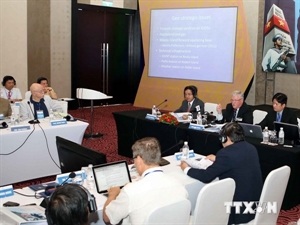 |
|
The conference (Source: VNA) |
An international conference themed “Hoang Sa-Truong Sa: Historical Truth” was held in the central city of Da Nang on June 20th, drawing the participation of nearly 100 leading Vietnamese and foreign researchers from various countries, including the US, Russia, France, India, Japan and the Philippines.
Opening the event, Associate Professor Doctor Pham Dang Phuoc, rector of Pham Van Dong University – one of the organisers – said the conference takes place in the context of escalating tension in the East Sea after China illegally positioned a drilling rig in Vietnam’s exclusive economic zone and continental shelf.
China ’s move seriously violates Vietnam ’s sovereign right and jurisdiction, aiming to realise its groundless and ambitious “nine-dash line” claim, he said.
The act is a new escalation by China in infringing international law, particularly the 1982 United Nations Convention on the Law of the Sea (1982 UNCLOS), changing the status quo in the East Sea and going against the Declaration on the Conduct of Parties in the East Sea (DOC).
Participants at the conference focused on analysing the nature of the dispute concerning Hoang Sa (Paracel) and Truong Sa (Spratly) archipelagoes, with various speeches, including those highlighting the role of international law in promoting cooperation, the scheme that China used to occupy Vietnam’s Hoang Sa archipelago, and the past, present and future of the “nine-dash line”.
Professor Carlyle A. Thayer, a former lecturer of the Australian Defence Force Academy and a specialist in Vietnam and Southeast Asia studies, said looking back to the 17 th and 18 th centuries, it is clear that Vietnam has remarkable evidence proving its claim over Hoang Sa archipelago.
In the 17th century, the Nguyen lords recruited sailors for 5-18 boats, forming the Hoang Sa Flotilla operating about five months at sea for each voyage to conduct catching activities, draw maps and survey and fish out goods from sunken ships there, he noted. Subsequent Nguyen Kings maintained the flotilla.
King Gia Long (1762-1820) officially possessed the archipelago in 1816. Gia Long’s successor, King Minh Mang, continued the activities of surveying and drawing maps in the area, built a temple there in 1835 and planted a stone stele carved with sovereignty claim of An Nam Kingdom, noted Professor Thayer.
The final declaration of the 1954 Geneva Conference temporarily separated Vietnam into northern and southern parts along the 17 th latitude. Hoang Sa was then put under the management of the southern government of the Republic of Vietnam. In 1956, the Republic of Vietnam protested the Chinese occupation of An Vinh islands and supplanted the French forces in Hoang Sa the same year, he said.
He also affirmed that the argument that the Democratic Republic of Vietnam recognised China’s sovereignty over Hoang Sa archipelago in 1958 is totally wrong.
In fact, the late Prime Minister Pham Van Dong’s diplomatic letter did not mention territorial and sovereignty issues relating to Hoang Sa and Truong Sa archipelagoes. It only acknowledged and approved China’s expansion of its territorial sea to 12 nautical miles and at the same time instructed Vietnamese agencies to respect the 12-nautical-mile limit declared by China, said Thayer.
He also held that the current dispute in areas around Hoang Sa must be settled on the basis of international law, including the 1982 UNCLOS.
Thayer also stated that China’s claims of “undisputable sovereignty” in the East Sea actually amounts to an invasion, and its use of battleships and aircraft in the area is a major obstruction to the management of common values in the East Sea.
Meanwhile, Patrick M. Cronin from the Centre for a New American Security (CNAS) asserted that China is becoming more authoritarian with its claims in the East Sea.
Pictures taken in March showed that China has been conducting construction in Gac Ma Island which belongs to Truong Sa archipelago, where Vietnam and China fought in March 1988.
At the beginning of May, China even positioned its drilling rig deep inside Vietnam ’s exclusive economic zone and continental shelf, he noted, adding that Chinese ships also rammed Vietnam ’s coast guard vessels.
These actions clearly showed China’s perverse attitude in the East Sea as part of its carefully calculated wider plot, stated Cronin.
The US supports international law and opposes any attempts to solve disputes through force, he said.
Professor Jerome A. Cohen, President of the US-Asia Law Institute of the New York Law University, said China’s efforts to prevent the engagement of international mechanisms is creating conditions for neighbouring countries to unite, strengthen their defence cooperation and seek greater support from world powers.
China’s moves have caused escalating and dangerous tension in the region, he said, concluding that Beijing should reconsider its hostility and instead listen to the judgment of fair arbitrating institutions./.